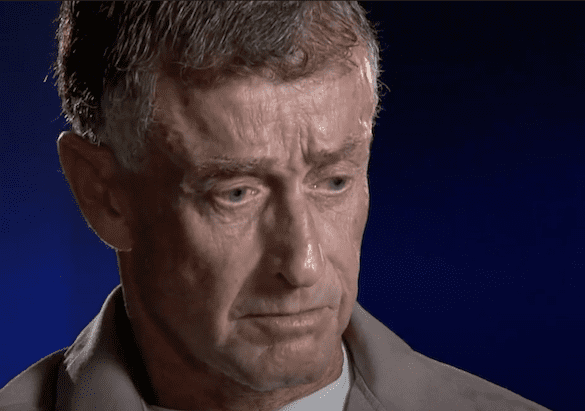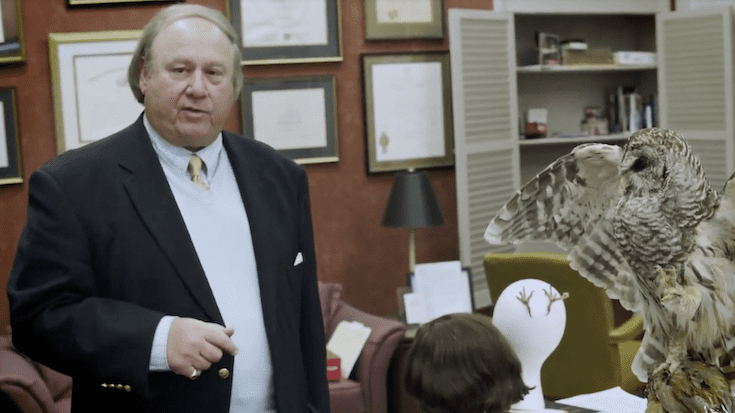
Gather around, true crime friends, because the story of The Staircase is a doozy – and, if you haven’t heard of The Owl Theory, heck you’re in for a treat. Many of you may have heard of the Michael Peterson case thanks to the drama, The Staircase, on Neon – but if not, this story is one of those ‘stranger than fiction’ kind of tales. After a bit of a recap, we talk to Larry Pollard, a former neighbour of the Petersons, who has become an internet sensation (and, at times, laughing stock), due to his unusual theory of what caused the events of The Staircase.
Larry Pollard is quite perplexed by his newfound fame – all due to a dramatic theory in a murder case that has left the internet stunned.
But we’ll get to that (and I’ll keep a recap of our 72 MINUTE chat as brief as can be). First, let’s go to the beginning of the story that has spawned multiple TV series, including the latest one on Neon, starring Colin Firth and Toni Colette.
The story takes place in the early 2000s in the upmarket suburb of Forest Hill in North Carolina, where Michael lived with his wife Kathleen along with one of their five children and stepchildren. Michael had enjoyed some success in the 90s thanks to three novels he penned, all set during the Vietnam War and inspired by his experience as a decorated former solider. While it’d been a while since he’d had a book published, he was still well known in the area for his column in the local newspaper. But, Michael was about to find himself at the centre of those newspaper headlines.
In the early hours of December 9, 2001, Michael dialled 911 to report that he had found Kathleen unconscious at the bottom of a staircase inside their mansion.
It had been a clear, mild evening and he and Kathleen had been sitting outside by their pool, enjoying a bottle of wine. Kathleen had also taken Valium, which had become a fairly regular occurrence. Michael says he must have dozed off in a chair and woke up at 2.40am to find himself still outside by the pool, alone. He went inside to go to bed where he presumed his wife was, but instead found her battered and non-responsive at the bottom of a steep staircase that led to the kitchen. Paramedics arrived and Kathleen was soon declared dead.
But that assumption that she had simply slipped on the staircase and fallen was quickly dismissed by many on the scene. For a start, there was an enormous amount of blood – it was splattered up the walls, with specks even reaching the ceiling. Then, shockingly, her autopsy found revealed a series of severe injuries, including a fracture in her thyroid cartilage and lacerations to the top and back of her head – they stretched across it, almost like little pitch forks.
The case quickly changed tack, with Michael now the primary suspect in a murder investigation. At trial, his credibility was attacked, with questions being raised about how truthful he had been about the medals he had won in Vietnam. Then the prosecution revealed they believed Michael was bisexual, as if this had some bearing on the murder (The early 2000s were clearly still a ridiculous time). They proposed Kathleen was unaware of his sexual preferences and that it was perhaps her discovery he had searched for gay porn that lead to an argument that evening – and ultimately her death. It was alleged a missing blow poke was responsible for the marks on her head. Meanwhile the defence called many witnesses, including bloody splatter experts who found them to be consistent with a fall – particularly with the valium and alcohol in her system.


But then came the death knell. The previous unexplained death of Michael’s close family friend, Elizabeth Ratliff, was discussed by the prosecution. Elizabeth had found dead at her home… at the foot of a staircase.
A full investigation and autopsy found no foul play. Elizabeth had been complaining to friends and family about dreadful headaches for weeks, and it was discovered she had a rare blood coagulation disorder – Von Willebrand’s disease – which caused a haemorrhage which was responsible for her sudden death. But the prosecution asserted that it gave Michael an idea for how to make a death look accidental.
Michael Peterson was found guilty of Kathleen’s murder and sentenced to life imprisonment without parole. Michael has vehemently denied he murdered his wife, but in 2017 he reluctantly entered an Alford plea (essentially a guilty plea) to have the charge dropped to a voluntary manslaughter. Having already served 98.5 months, he was released from prison. He still maintains he is innocent.
And he has a large following of supporters, particularly following the hit Netflix series, The Staircase. But there was a theory and potential explanation of Kathleen’s death that wasn’t in that series – or ever presented in court. And last year there was a new documentary, An American Murder Mystery: The Staircase, on Investigation Discovery, which finally went into that theory, all told by the man behind it himself: Larry Pollard.
I had the great pleasure of speaking to Larry this week and he was EAGER to tell his side of the story, to say the least. My 15-minute phone conversation with him (while he was on holiday with his wife, no less) stretched on for a whooping 72 minute as Larry explained every in and out of his meticulously researched theory.
Larry has become an internet sensation (and, at times, laughing stock), due to his unusual theory which he says perfectly explains Kathleen’s death – and exonerates Michael.


Larry’s theory is that Michael didn’t kill his wife. She didn’t just slip on the staircase. There was no masked intruder. “This woman,” he tells me, “was attacked by a wild bird of prey – i.e. an owl.”
Now, I know what youre thinking, because it’s likely the very same “What. The. Hell?” that went through my head when I first heard about it. But, it’s worth hearing Larry out.
For a start, Larry is no internet hack. The now 70-year-old has practiced law for more than 40 years and became an Associate Attorney General in the Department of Justice assigned to the special prosecution division of the North Carolina Attorney General’s office. He also has a unique perspective having lived on the same street in Forest Hill for more than 50 years – 10 of which were spent as Michael and Kathleen’s neighbour. As a child he played in their home, and visited the house often over the years so is very familiar with the layout – and that particularly steep set of stairs, which he says were originally from the servants quarters. He’s also a Christian, which he says is important to note, because he’s never been asked or paid to devote so much of his time to this case. “It says in the Bible to love your neighbour as yourself. If your neighbour needs help, help him,” he explains.
He and Michael weren’t especially close, but he describes him as a great neighbour. “He was always very polite, very courteous, very helpful and very responsive,” he says. He remembers the last time he saw Kathleen, about a week before her death, leaving the house hand-in-hand with Michael.
The day leading up to her death, Larry was out deer-hunting (which he says is an important factor later on), but he came home in time to take his wife out for dinner to a spot that Kathleen and Michael recommended. They came home, put on a football game, “and as I normally do, I fell asleep,” remembers Larry. But then, something jolted him awake. “What was that?” he asked his wife, who was still fast asleep next to him on the couch. He got up, took a look round and couldn’t see anything. He turned off the TV and went to bed. The next morning, the street was filled with police.
When he heard the news that Kathleen had fallen on the stairs, he was saddened, but could immediately picture where it would have happened, and wasn’t surprised she didn’t survive the fall. “Those stairs were narrow,” he tells “and they used to have a mechanical chairlift in them, which I imagine she could have hit her head on.”
And when the case became a murder investigation, he was shocked. He couldn’t see Michael as the killer. “I just couldn’t imagine that he would kill his wife,” he says. “The whole case seemed very unusual. It just didn’t sit with me right. There was something on my gut that made me feel something was wrong.”
When the trial began – and was televised, he became more convinced of Michael’s innocence. From his experience examining crimes, this one just didn’t make sense.
He remembers the moment clearly when he saw the images of the wounds to Kathleen’s head. “I thought to myself, ‘Those look like bird tracks!’ but they were too big to be bird tracks.”
Which is when he started thinking back to his hunting – he often went out into the forests to hunt for deer or turkey and had decades of experience under his belt. “Often when you hit a deer, it doesn’t just fall dead on the spot, it’ll run away and you’ll have to track it. I had a deer mounting on my wall in my mancave by the TV, and I had this feeling, like the eyes of that deer were trying to communicate something with me. Then I remembered the night I shot it. I was in the forest and I went over to where it had been standing and I looked around and I took three or four steps and there I saw one spot of blood on the ground, and I followed those little drops of blood. That’s when it all hit me like a bolt of lightning. My job as a prosecutor was interpreting evidence, and I had my case.”
The blood trail in the Kathleen Peterson case didn’t start in the stairwell – there was a single drop of blood outside, leading into the home. Then another one by the door, and another on the landing. Larry believed she was attacked outside, then ran inside to get away from what had attacked her, dropping spots of blood as she ran to safety. “The prosecutors did the blood trail backwards. They thought the blood trail outside came afterwards, carried on something else. But every hunter would see it otherwise, it was a trail of something injured running to find safety.”


He believes her extensive wounds began bleeding profusely as she got inside. “There were two sets of blood splatter – the first would have happened when she ran to that safety point and turned to see what it was that attacked her in the darkness of the middle of the night. Now, she’s losing a lot of blood and wants to call for help, maybe get the telephone. She’ll be in pain, because she has those wounds to the head – but her skull is not cracked. Now, it’s very hard to beat someone to death with an object and not break the skull. It’s here, she would have fainted, her feet slipping on the blood beneath her, leaving blood on the soles of her feet.” Kathleen then died from blood loss – something the coroner believed happened around 90 to 120 minutes later.
The most convincing part of Larry argument is what was included in the official autopsy report. In her hand, Kathleen had a chunk of her hair, pulled out from the root in her hand. Amongst her hair were three bloody microscopic feathers.
More specifically, those particular type of feathers can be found on the talons of owls. Larry believes she would have pulled her own hair out as she attempted to get the owl off the back her head, as its powerful talons latched onto her scalp.


Larry remembers his dogs often barking at owls and seeing them in the neighbourhood and there is a (rather surprising) well-documented history of owl attacks on humans. “She was hit in back right part of the head, where 90% of all owl attacks on humans occur.” He consulted with ornithologists, who supported his theory.
But still, despite some convincing evidence, the Owl theory has been scoffed at by the Police Department, and Michael’s attorney were hesitant to present the theory to a jury, despite now believing it had legs. “I had tunnel vision,” his defence lawyer, David Rudolf said last year. “I had a theory that it was a fall, and anything that was inconsistent with that theory or might have been, I came up with my own explanations for.” He now believes the theory is highly plausible.
And as we wrap up our chat, it’s clear there’s someone else who certainly believes in Larry. “Oh hang on,” he says, “my wife wants to talk to you.”
“Is this Alice? Alice this is Brenda, his wife of 36 years this June,” she tells me. “This man has been ridiculed and laughed at for the story he has just told you. He’s been mocked, but you know what is the driving force and passion for him: you have to do the right thing and it takes courage to do that. And what are you afraid of media, and the family and friends? You’re afraid of the truth? Because the truth is Michael didn’t kill his wife. Larry knows that.”

